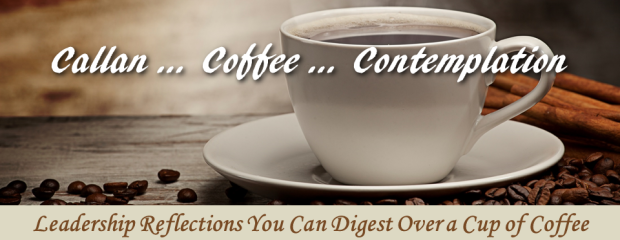Callan…Coffee…Contemplation for the Week of December 15th
How You Go Far
The other day I was asked this question by a young leader: “What’s the best way for me to go far as a leader?” After some thought, I answered this way: It isn’t really about how far you go as a leader; it’s about how you go far. The ultimate test of leadership is not the final tally of personal rank, status, or position, or how high up the corporate ladder we climbed. Instead, the ultimate test is the quality and consistency of our character during the entire climb. The best focus for young leaders isn’t the corporate ladder, but rather– the climber. It is far more important to master oneself, developing high character, virtue, purpose, and fortitude, than to focus on the key success nodes along a career path. For me, this distinction is crucial because it rightly distinguishes between success and significance. Success measures how far you go, where significance measures the more supreme metric: How you got there and what you left behind for others. In the end, you aren’t remembered for how far you go, but for how you go far.
Dogged Resolution
When reflecting on great leadership, I can’t think of a single heroic leader who wasn’t doggedly resolute. What this reminds me of, and should inspire us all, is this maxim of leadership: “It isn’t whether you win every battle; it is only important you don’t lose the last battle.” We see this truth borne out in the lives and leadership journeys of Washington, Lincoln, Churchill, Gandhi, King, and a host of others whose lives reflect occasional defeat yet a growing resilience enabling them to ultimately reach the high ground. Like Ernest Shackleton’s epic journey across Antarctica, all leaders will at times become figuratively shipwrecked and be challenged by this critical choice: Do I press ahead or turn back? Fate, in this regard, is not the guarantee of a right decision. Fate is simply the crossroads at which we find ourselves standing at a given moment. The crossroads will reveal our character via our choice. What’s the lesson? The crossroads awaits us all; what we do today, and every day, either strengthens our resolve or weakens it.
The Leader as Drummer
When reflecting on leadership we tend to focus on foreground elements such as, what leaders do. I prefer to focus instead on background elements such as, who leaders are. In this regard, I like to think of great leaders as drummers. Great leaders possess the ability to create a resonant drumbeat from which others first hear the call to action, and then, around which action is transformed into unified purpose. The characteristic of the drumbeat is never tactical nor technical; it is more the texture of perennial knowledge. The rat-tat-tat of the leader’s drum constantly sounds a cadence answering these elementary questions: Who are we? Why do we exist? What do we stand for? Where are we headed and why? For others to march towards the high ground of purpose, leaders must create a compelling drumbeat to call us to intentional action.
Recital and Improvisation
How does one master a craft as complex as leadership? The honest truth is—there’s no exact formula for mastery. Let’s use jazz as a metaphor to describe the elements of self mastery. Initially, an aspiring jazz musician must learn the basics; notes, chords, scales, rhythms, and harmonies. This foundational grounding is necessary because the musician must allow these cornerstones to become second nature. During early development, the focus is on the recital. Energy is poured into reciting back, quite literally, the basics of the craft. However, as time progresses a threshold in mastery must be crossed. The jazz musician must learn how to improvise; to take the foundations and then, through intuitive interpretation, adapt to the requirements of the moment. The same evolution occurs in pursuit of masterful leadership. We start by focusing on the recital, but to become truly heroic leaders, we must master the art of improvisation. Yes, we first learn to read sheet music. But in time and in action, we must learn to improvise masterfully to the needs of the moment.
An Artist’s Eye
Expert leadership is the admixture of detail and big picture. As such, I believe great leaders learn to develop what I call an artist’s eye: They see the beauty of small detail while equally perceiving the whole rendering. Great leaders see the grand end state and never lose sight of the end game, but equally and simultaneously–they possess great intellectual curiosity for detail. Great leaders are fascinated by how things work, why they work, and how they can be made better. Great leaders combine broad strokes and fine lines, enabling them to embrace strategic outcomes while also perfecting the intricate details of execution and performance. Great leaders never lose sight of the inspiration of the big picture, but they also never forget the vitality of small details. We must all learn to develop an artist’s eye and create the leadership brushstrokes, both broad and fine, to blend the top and bottom lines.
Check back next Monday for a round up of this week’s social media shares. Or check us out on Facebook, Twitter, Google+, or Pinterest to see our posts every day!
Tweet Share






